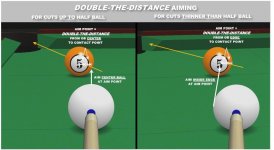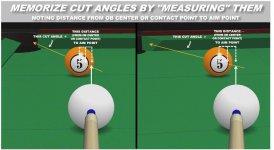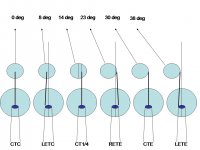I don't know of a link to one off the top of my head. I was going to draw you some pictures but it's been a pretty hectic day.
Here is a simple one that works pretty well for a lot of shots. I made this one up but I'm sure I'm not the first one to try it. I've heard that Shane uses something related to this. For cut shots less than 15 degrees or so - aim the center of the cue stick at the contact point on the object ball. For cuts bigger than that, line up on the cue ball so that the edge of the cue on the side you are cutting to is pointed at the contact point. Aiming the center of the cue at the contact point works really, really well for long shots that are almost straight in.
The contact point is the point on the object ball that you want the cueball to make contact with to pocket the ball. The point opposite the object ball from the point closest to the center of the pocket. If you visualize a ghost ball it's the point where the ghost ball would be touching the object ball.
This will have you nailing so many shots its silly. When you can 'see' it well, then start identifying the shots that it doesn't work for and learn how to adjust for them. Maybe you'll be aiming the edge of the cue at the edge of the OB for thin cuts. Whatever. The important thing is that once you start to see how to adjust a system then you know when it works and when it doesn't and how to use it even when it might not give you the 100% correct shot line.
It's still a judgement call because you have to judge the contact point and the center of the cuestick for smaller cuts. To me it's easier than trying to judge an amount of overlap or something similar.
Double the distance is a method that is geometrically correct but relies on judgement and accurate aim. If you imagine a line between the center of the cue ball and the center of the object ball and the look at the distance between that line and the contact point - the aim point is exactly twice that distance. Pivot systems are largely a way to arrive that that aim point without having to think about doubling the distance.
Before I ever heard of CTE (late 80s/early 90s) I developed a pivot system to try and arrive at double the distance. It worked pretty well but the biggest flaw in all of these type of aiming systems is that they don't account for the effects of spin. Since I could always see the correct aim line without english, I abandoned that and started focusing my efforts on aiming systems or frameworks that would help incorporate english. I have some interesting developments along that line that I would like to share on the forums when I have time.
All aiming systems are dependent on eye position relative to the cuestick and the characteristics of your cue. The more they incorporate english or a pivot, the more they can be affected.



